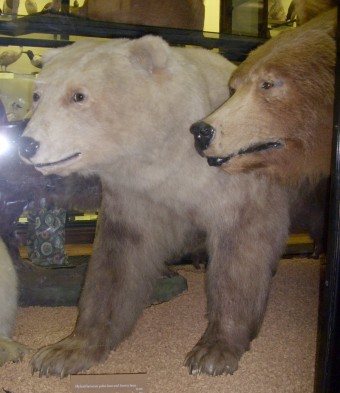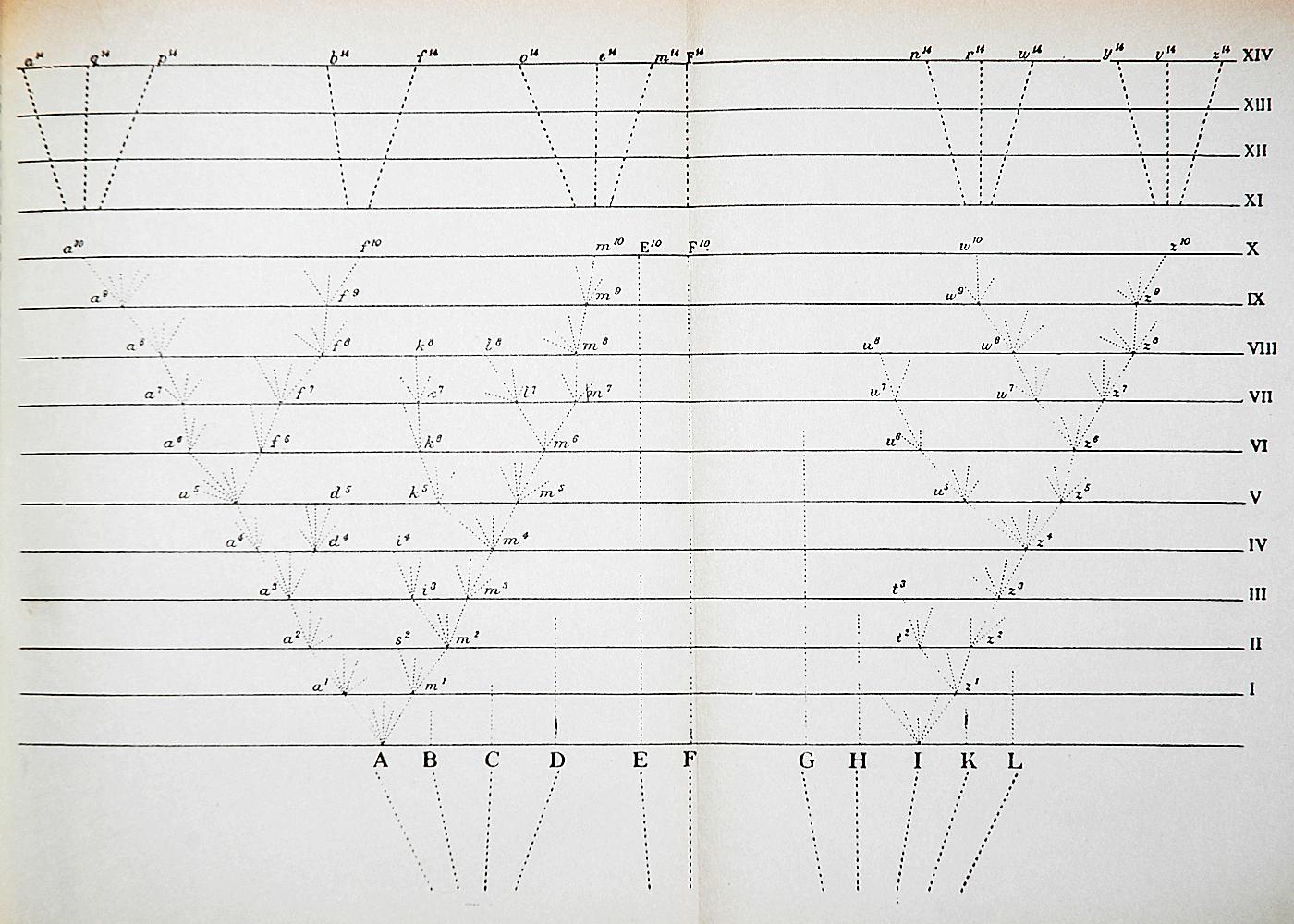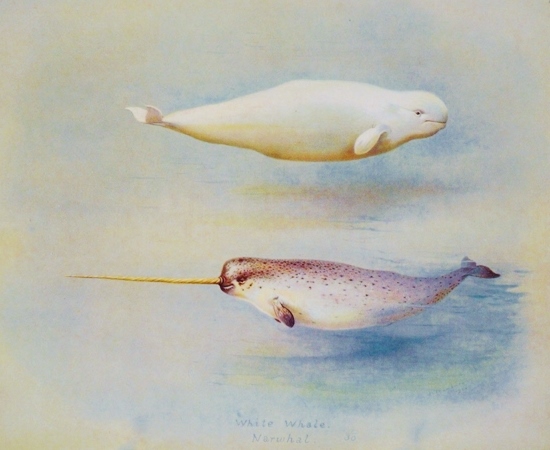I thought it was a joke when I first heard about it two or three years ago: a bear that was part-grizzly, part-polar bear, roaming the land where tundra meets sea ice? People called it the grolar bear, I was told, or sometimes the pizzly bear.
Pizzly bear? I thought at the time. Come on.
But the hybrid is very real. (Although, clearly, “grolar bear” is the superior choice of name.) And if some scientists’ predictions are correct, it could be just one of a whole host of potential hybrid mammal species to emerge from the Arctic as it continues to warm.

(Photo: Sarah Hartwell/Wikimedia Commons)
“We’ve known for decades that, in captivity, grizzly bears and polar bears will hybridize and in fact produce fertile offspring,” says Dr. Brendan Kelly by phone from Anchorage, where I caught him after a conference. But he hadn’t heard about a hybrid appearing in the wild until 2006, when a hunter in the Canadian Arctic took down an odd-looking bear—white with brown patches—that, DNA testing later confirmed, was part-grizzly, part-polar bear. Another hybrid, the second-generation offspring of a grolar bear and a grizzly, was killed by a hunter, and later tested, in 2010, also on the Canadian side of the border. And Kelly’s heard about at least two more unconfirmed appearances by hybrids in both Alaska and northern Canada.
These days, Kelly is the chief scientist and director of conservation research at the Monterey Bay Aquarium. But he has spent more than 35 years working in Alaska, studying Arctic marine mammals. When he heard about grolar bears cropping up in the wild, he was intrigued.
“It’s important to recognize that polar bears branched off of grizzly bears rather recently in evolutionary terms,” Kelly says, “and when a species splits into two it doesn’t happen overnight. It takes a period of isolation for them to evolve differences, and it often takes an even greater period of isolation for them to become so different that they can’t hybridize if they re-encounter one another. So this happens over and over and over again in evolution. It’s really sort of the basis of the Darwinian theory.”
Kelly invokes the famous illustration from The Origin of Species of the branching tree. “What it doesn’t show is that sometimes those branches grow back together,” Kelly says. “[Darwin] was, and rightfully so, focused on the creation of new species, but sometimes after a period of separation, species that were beginning to diverge come back together and fuse and return to being one species. And this may very well be where polar bears and grizzly bears are headed. (But of course this is evolution so it’s not determinate.)”

(Photo: Public Domain)
This isn’t quite as simple as polar bears migrating south and grizzly bears migrating north as the ice melts and the climate warms—though that plays a role. Polar bears and grizzly bears have shared some overlapping terrain for centuries. “But it’s becoming more frequent, and in greater parts of the range,” Kelly says. “And it’s a matter of timing as well—the important thing is, are you in the same place at the same time during the breeding season?”
Not much is known yet about the physical characteristics of the hybrids, aside from the crucial fact that they are fertile, not sterile—there’s too little evidence of the bears for serious study. But scientists observing grolar bears in captivity have noted that, on the one hand, the bears exhibit some typical hunting characteristics of polar bears, rather than grizzly bears—and on the other hand, that they are much weaker swimmers than polar bears. Kelly says that can be typical of hybrid species: that they sometimes lack the specialized instincts of either parent species, leaving them caught in between.
When Kelly heard about the grolar bears back in the late 2000s, it got him thinking about other marine mammal species—whales, walruses, seals, and sea lions—that might begin to hybridize as the permanent sea ice that has separated their populations for centuries continues to recede. As it turns out, marine mammals are particularly prone to this type of inter-species reproduction.
Sexual reproduction between species depends on each animal’s chromosomal number: if the numbers don’t match, the two animals won’t produce fertile offspring. And it’s “a peculiarity of marine mammal species,” Kelly says, that they can vary widely in their morphology—that is, their physical form—while retaining a matching chromosomal number. Harp seals and hooded seals, for instance, are considered by taxonomists to be not just different species, but different genera—yet they can produce fertile hybrid offspring, and DNA confirms that they have done so in the wild. Dall’s porpoises and harbor porpoises are another example. “Again we classify them in different genera,” Kelly says. “Turns out they’re hybridizing quite readily off the coast of British Columbia.”
Here’s the part where Kelly really blew my mind: There’s evidence to suggest that beluga whales and narwhals are mating in the eastern Arctic, he told me. A skull that appeared to be from a hybrid of the two was found in Greenland, and Inuit from the same area have reported sightings of what appear to be living hybrids. Meanwhile, far to the west in the Bering Sea, whale experts believe there’s been at least one sighting of a hybrid whale, a cross between a right whale and a bowhead.

(Illustration: Public Domain)
My initial reaction to all this? Grolar bears! Narlugas! Cool!
But the hybridization is cause for concern, especially when one species—like the polar bear or the extremely endangered North Pacific right whale—is at risk.
“People often think of extinctions as, well, simply, a population becomes smaller and smaller and smaller until there’s none left,” Kelly says. “And that happens.” But the process is more complex than that, and sometimes, a contributing factor to the extinction is an at-risk species hybridizing with another, more populous one.
It’s a question of probabilities. Imagine that the polar bear population is continuing to decline and continuing to decline. With every mating season that rolls around, each remaining polar bear will be statistically more likely to encounter and mate with a grizzly rather than a fellow polar bear. That will produce more hybrids, which will also be more likely to mate with a grizzly bear or a fellow hybrid. And so on.
“It can be the final nail in the coffin,” Kelly says.
The combined sea ice of the Arctic and Antarctica, according to Kelly, is larger than any continent except Eurasia. “This is a huge habitat, and it is going away in a matter of decades,” he says. “And that is very rapid in evolutionary terms.
“When environments change, that can lead to the proliferation of new species—what we call adaptive radiation,” Kelly says. But that outcome typically arises from gradual environmental change. “When environments change very abruptly, instead of leading to adaptive radiation it tends to result in large extinction events.”
Grolar bears: no joke after all.
Dispatches From a Changing Arctic is a biweekly series of reported stories from Alaska and the three Canadian northern territories.



